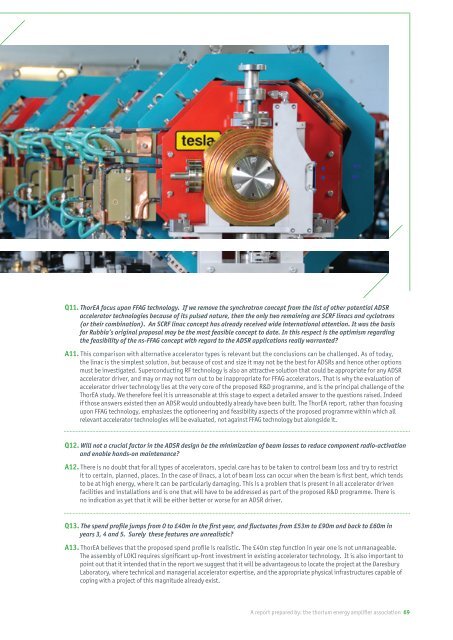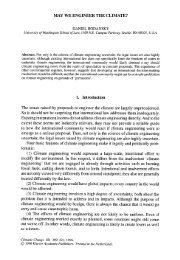ThorEA - Towards an Alternative Nuclear Future.pdf
ThorEA - Towards an Alternative Nuclear Future.pdf
ThorEA - Towards an Alternative Nuclear Future.pdf
Create successful ePaper yourself
Turn your PDF publications into a flip-book with our unique Google optimized e-Paper software.
Q11. <strong>ThorEA</strong> focus upon FFAG technology. If we remove the synchrotron concept from the list of other potential ADSR<br />
accelerator technologies because of its pulsed nature, then the only two remaining are SCRF linacs <strong>an</strong>d cyclotrons<br />
(or their combination). An SCRF linac concept has already received wide international attention. It was the basis<br />
for Rubbia’s original proposal may be the most feasible concept to date. In this respect is the optimism regarding<br />
the feasibility of the ns-FFAG concept with regard to the ADSR applications really warr<strong>an</strong>ted?<br />
A11. This comparison with alternative accelerator types is relev<strong>an</strong>t but the conclusions c<strong>an</strong> be challenged. As of today,<br />
the linac is the simplest solution, but because of cost <strong>an</strong>d size it may not be the best for ADSRs <strong>an</strong>d hence other options<br />
must be investigated. Superconducting RF technology is also <strong>an</strong> attractive solution that could be appropriate for <strong>an</strong>y ADSR<br />
accelerator driver, <strong>an</strong>d may or may not turn out to be inappropriate for FFAG accelerators. That is why the evaluation of<br />
accelerator driver technology lies at the very core of the proposed R&D programme, <strong>an</strong>d is the principal challenge of the<br />
<strong>ThorEA</strong> study. We therefore feel it is unreasonable at this stage to expect a detailed <strong>an</strong>swer to the questions raised. Indeed<br />
if those <strong>an</strong>swers existed then <strong>an</strong> ADSR would undoubtedly already have been built. The <strong>ThorEA</strong> report, rather th<strong>an</strong> focusing<br />
upon FFAG technology, emphasizes the optioneering <strong>an</strong>d feasibility aspects of the proposed programme within which all<br />
relev<strong>an</strong>t accelerator technologies will be evaluated, not against FFAG technology but alongside it.<br />
Q12. Will not a crucial factor in the ADSR design be the minimization of beam losses to reduce component radio-activation<br />
<strong>an</strong>d enable h<strong>an</strong>ds-on mainten<strong>an</strong>ce?<br />
A12. There is no doubt that for all types of accelerators, special care has to be taken to control beam loss <strong>an</strong>d try to restrict<br />
it to certain, pl<strong>an</strong>ned, places. In the case of linacs, a lot of beam loss c<strong>an</strong> occur when the beam is first bent, which tends<br />
to be at high energy, where it c<strong>an</strong> be particularly damaging. This is a problem that is present in all accelerator driven<br />
facilities <strong>an</strong>d installations <strong>an</strong>d is one that will have to be addressed as part of the proposed R&D programme. There is<br />
no indication as yet that it will be either better or worse for <strong>an</strong> ADSR driver.<br />
Q13. The spend profile jumps from 0 to £40m in the first year, <strong>an</strong>d fluctuates from £53m to £90m <strong>an</strong>d back to £60m in<br />
years 3, 4 <strong>an</strong>d 5. Surely these features are unrealistic?<br />
A13. <strong>ThorEA</strong> believes that the proposed spend profile is realistic. The £40m step function in year one is not unm<strong>an</strong>ageable.<br />
The assembly of LOKI requires signific<strong>an</strong>t up-front investment in existing accelerator technology. It is also import<strong>an</strong>t to<br />
point out that it intended that in the report we suggest that it will be adv<strong>an</strong>tageous to locate the project at the Daresbury<br />
Laboratory, where technical <strong>an</strong>d m<strong>an</strong>agerial accelerator expertise, <strong>an</strong>d the appropriate physical infrastructures capable of<br />
coping with a project of this magnitude already exist.<br />
A report prepared by: the thorium energy amplifier association 69



